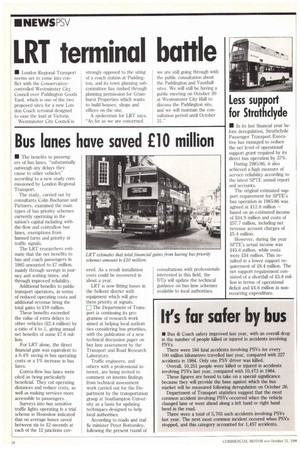Bus lanes have saved £10 million
Page 20

If you've noticed an error in this article please click here to report it so we can fix it.
• The benefits to passengers of bus lanes, "substantially outweigh any delays they cause to other vehicles" according to a new study commissioned by London Regional Transport.
The study, carried out by consultants Colin Buchanan and Partners, examined the main types of bus priority schemes currently operating in the nation's capital including withthe-flow and contraflow bus lanes, exemptions from banned turns and priority at traffic signals.
The LRT researchers estimate that the net benefits to bus and coach passengers in 1985 amounted to 27 million, mainly through savings in journey and waiting times, and through improved reliability.
Additional benefits to public transport operators, in terms of reduced operating costs and additional revenue bring the total gains to 210 million.
These benefits exceeded the value of extra delays to other vehicles (22.4 million) by a ratio of 4 to 1, giving annual net benefits of some .27.6 million.
For LRT alone, the direct financial gain was equivalent to a 0.4% saving in bus operating costs or a 1% increase in bus fares.
Contra-flow bus lanes were cited as being particularly beneficial. They cut operating distances and reduce costs, as well as making services more accessible to passengers.
Surveys into bus sensitive traffic lights operating in a trial scheme in Hounslow indicated that on average buses saved between six to 12 seconds at each of the 12 junctions coy
ered. As a result installation costs could be recovered in about a year.
LRT is now fitting buses in the Selkent district with equipment which will give them priority at signals.
The Department of Transport is continuing its programme of research work aimed at helping local authorities considering bus priorities, with the publication of a new technical discussion paper on bus lane assessment by the Transport and Road Research Laboratory.
Traffic engineers, and others with a professional interest, are being invited to comment on interim findings from technical assessment work carried out for the Department by the transportation group at Southampton University as a basis for updating techniques designed to help local authorities.
According to roads and traffic minister Peter Bottomley, following the present round of consultations with professionals interested in this field, the DTp will update the technical guidance on bus lane schemes available to local authorities.
























































































































